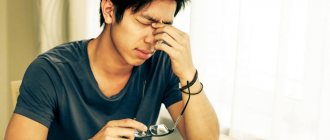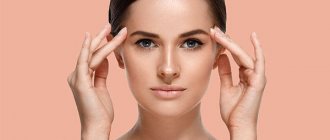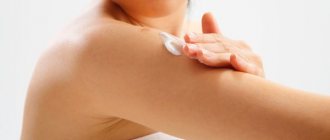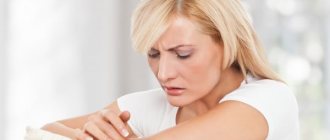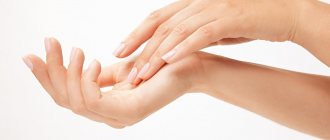Any changes in the condition of the child’s skin should alert parents. When a baby’s skin becomes dry, red, cracks, itches or peels, this indicates the development of pathological processes in his body, improper care or a deficiency of any substances necessary for harmonious development. What is the danger of dry skin on a baby’s body, arms, legs, and head? Why can such a symptom occur in newborns, infants up to one year old, preschool children, and primary schoolchildren from 7 years of age? How to treat and prevent such conditions? Let's talk about this topic in detail.
Main characteristics of healthy baby skin
Bathing oil: gentle care for baby's skin
Soft, delicate, velvety - this is how we usually talk about baby's skin. But even if the child is healthy, it does not become so immediately after birth.
Why? Explains Alexander Prokofiev, dermatovenerologist, medical expert at La Roche-Posay: “After the baby is born, his skin needs to adapt to the environment. In newborns, this process has not yet been completed, so their skin is more dry, more susceptible to irritation, redness, and easier to injure. These features disappear with age.”
https://www.youtube.com/watch?v=upload
Normally, a child’s skin should be pale pink and have good turgor, that is, be soft and elastic to the touch.
Causes of dry skin in children
The process of peeling off the top layer of skin in adults and children is called desquamation in medicine and can be caused by a huge number of factors. Peeling is often accompanied by itching, which intensifies if the cause is not eliminated. Children reflexively scratch the dermis, sometimes introducing additional infections into the body and provoking the development of complications, which complicates treatment.
In almost every newly born child, parents notice peeling skin after some time. Babies born at 41-42 weeks of pregnancy are especially susceptible to this.
In most cases, this is a purely physiological process associated with a change from an aquatic environment to an air one. In the womb, the child’s body is covered with a thin protective layer, which gradually comes off in small scales, without causing any concern to the child and disappears completely in 7-10 days.
Other causes of peeling skin in a newborn:
- hard water for bathing;
- reaction to breast milk or adapted formula;
- imperfect function of the sebaceous glands.
These reasons are absolutely harmless and disappear on their own as the baby grows.
Some parents may notice that the natural folds become red, inflamed, and the skin begins to peel off. The cause of diaper rash is improper care; sweat accumulates in the folds and causes irritation.
Weather
Children's skin reacts to changes in humidity and temperature. Most often, peeling occurs after the onset of the heating season, as the delicate skin of the whole body reacts to dry, warm air in the room.
During the cold season, children may experience irritation and peeling in open areas (face, hands) from exposure to wind and cold air. The skin becomes rough and cracks.
Very rarely in winter, frostbite of the limb and face is possible. In severe forms, blisters form, the skin peels off in layers, and tissues die.
In the summer, the cause of peeling and peeling of the skin is prolonged exposure to the open sun, burns of varying severity.
The children's nervous system reacts sharply to different situations. Stress can be caused by separation from mom, starting kindergarten or school, or moving to a new place of residence. The child’s body may react to them by causing itching and flaky areas.
Vitamin deficiency is another common cause of peeling skin in children. It occurs due to a lack of vitamin A and E. Vitamin deficiency often occurs in the spring-winter period and after illness. The skin of children throughout the body becomes dry and rough to the touch, and on the palms and fingers it begins to peel off and hangnails appear.
Allergy
An allergic reaction, in the form of itching or the appearance of flaky lesions on the skin of a child, can be caused by: the introduction of a new product into the diet of a baby or a nursing mother, the use of cosmetics or household chemicals (washing powder, softener), the flowering of certain plants, animal hair, diapers or dust.
Some babies can react this way even to their parents' perfume or deodorant. Such reactions mainly appear on the child’s cheeks, fingers, or in places where the skin comes into contact with the irritant. Their intensity can vary from slight redness to the formation of deep cracks.
Clothes or shoes
Very often, the delicate skin of children begins to peel off from wearing clothes and shoes made of synthetic materials. Such tissues disrupt the circulation of oxygen, causing increased sweating. A humid and warm environment is an excellent place for various microorganisms to live, which easily penetrate enlarged pores.
Diseases
The cause of skin problems in a child can be one of the following diseases:
- Atopic dermatitis.
Causes scaly, slightly raised pink spots all over the body in children under 3 years of age. The cause may be allergies, heredity or weakened immunity.
- Fungal infections in children.
Skin damage occurs upon contact with adult carriers, animals, and dirty objects due to an imperfect immune system. Fungal infection can occur on any part of the body, but the feet and toes are most often affected. Focal redness, peeling, cracks, and pustules appear on the skin.
- Dysbacteriosis.
It often develops after serious illnesses treated with antibiotics. In addition to digestive disorders, dysbacteriosis is manifested by peeling and peeling of the skin on the fingers.
- Helminthiasis (infection with pinworms, roundworms or other parasites).
Intoxication of a child's body with waste products of worms can cause skin itching (sometimes very severe), dry skin and redness in different parts of the body.
- Hypothyroidism.
Weakened thyroid function. Lack of hormones is expressed by the appearance of excessive dryness and flaking on the elbows and knees. It is important to identify the disease as early as possible in order to prevent developmental abnormalities.
- Different forms of lichen (pityriasis versicolor, pink).
The fungal disease affects areas of the skin with increased sweating: armpits, chest, abdomen, back, arms. Initially, small, slightly protruding pink spots appear, the surface of which is covered with small scales. Under the influence of ultraviolet radiation they lighten and gradually occupy an increasing area.
- Scarlet fever.
We invite you to familiarize yourself with Non-injection skin biorevitalization
https://www.youtube.com/watch?v=ytaboutru
Bacterial infection caused by activation of streptococci. The disease begins with a rise in temperature, then itching and rashes all over the body, the child’s palms and fingers turn red and begin to peel.
- Scabies.
A dermatological disease caused by scabies mites penetrating under the skin. The pathology is characterized by itching, the intensity of which intensifies in the evening and during sleep. Small ulcers and red stripes (parasite passages) are observed on the skin of the abdomen, buttocks, arms, and between the fingers. One of the characteristic signs of scabies is the peeling of a thin layer of skin on the hands.
Dry, flaky skin in a child may be a feature of the body or arise as a manifestation of hereditary diseases:
- Vitiligo.
A genetic disorder caused by a lack of melanin in certain areas of the dermis. White, occasionally flaky spots appear on the child's skin. Most often, the disease is inherited, but it can also occur in a healthy child after severe infectious diseases or stress.
- Psoriasis.
An incurable dermatological disease that manifests itself as red, constantly itchy spots on the child’s scalp, elbows and knees. The skin becomes rough, covered with cracks and crusts. The disease worsens with weakened immunity or severe stress.
- Ichthyosis.
A congenital disease that appears after 2 years of age. The child's skin becomes dry and large white scales appear on it. After they fall off, a pattern resembling fish scales forms on the skin.
Sometimes a rash and peeling of the skin can occur after an insect bite or contact with certain types of plants. Sometimes the cause of desquamation is the child’s love of water procedures. Prolonged exposure to water causes the skin on the child’s feet and palms to peel off.
It is almost impossible to independently determine the cause of peeling skin in children. If peeling continues for a long time or occurs periodically, you need a mandatory consultation with a pediatrician or one of the specialized specialists: a dermatologist, an endocrinologist.
The child’s hands are constantly in contact with air and various objects, so peeling is caused by both external factors and pathological changes in the body.
Legs: foot and heels
They experience enormous stress during the day; children are rarely persevering and are on the move almost all the time. Prolonged contact of the foot with various materials, friction on the surface, leads to gradual hardening of the skin in these areas, especially on the heels.
Because the skin on a child's toes is very thin, it is more susceptible to fungal infections than on adults. In childhood, it is still soft, so desquamation causes severe discomfort.
“Children’s skin can become dry under the influence of both external and internal factors,” says Alexander Prokofiev. Let's list the external reasons.
- 1 Improper care
Using detergents more than once a week, water is too hard for bathing (it is better to pass it through a filter). - 2
Exposure to the sun without protectionThe baby’s skin is not able to resist the effects of UV rays, so children under one year old can be kept in the open sun for no more than five minutes a day, and even then “under the cover” of special baby creams with high SPF.
- 3
Dry indoor air and overheatingOverheated air is a test for a child’s imperfect thermoregulation system: the skin turns red, becomes hot, and irritation appears. The same thing happens if you wrap your baby up too much.
- 4
Exposure to bad weatherCold air coming into contact with delicate baby skin can cause redness, dryness and irritation.
- poor nutrition, which is expressed in a lack of vitamins;
- lack of water;
- some diseases, primarily skin and endocrine;
- circulatory disorders;
- helminthic infestation.
Very dry baby skin is a cause for concern. It is more vulnerable, easily injured, and damaged skin is more susceptible to infections, especially in infancy.
- atopic dermatitis;
- ichthyosis (a disorder of keratinization of the skin, which manifests itself in the form of scale formation);
- other diseases, including diabetes.
If dryness is a persistent feature of your child's skin, it makes sense to first consult with your pediatrician and then see a dermatologist for appropriate treatment.
Friction from shoes and clothing can also cause redness and flaking of baby's delicate skin. Sometimes the cause of hypersensitivity is the diseases mentioned above. In any case, choose clothes and shoes for your baby made from natural materials, and use children's hypoallergenic powders for washing. To prevent dry feet in summer, it is better to wear open-toed shoes.
Factors influencing the appearance of dermatitis
Dry skin in a newborn is a natural phenomenon caused by a change in microclimate. The epidermis does not fully adapt to the environment familiar to an adult; it suffers from the humid and warm microclimate of the womb.
But in some cases, rough spots on a baby’s body may indicate insufficient care or pathology.
The main causes of dry skin in a child include:
- Insufficient humidity level in the children's room. Dry spots on the skin are especially common during the cold season, when radiators are heated or an air heater is used.
- Poor hygiene. Breasts should not be washed every day using detergents. Children should be washed with plain water and liquid soap should be used once a week. The epidermis can also dry out from rare hygiene procedures, when an inflammatory process develops and dry spots appear on the skin that flake.
- Incorrect functioning of the sweat and sebaceous glands. These glands begin to function only after the child is born. Over time, dryness of this etiology is eliminated on its own.
- Impaired metabolism. This may be caused by pathologies of the pancreas or thyroid gland.
- Vitamin deficiency. It is usually detected in babies who are breastfed if the mother does not receive vitamin E and A.
- Allergic manifestations. Dry dermatitis occurs as a reaction to foods consumed by the mother, medications, hygiene products, and diapers.
You also need to monitor external temperatures. The skin dries out if you bathe your baby in hot rather than warm water.
After all, thirst is the fundamental cause of dry epidermis. A child’s nutrition is an important factor affecting the condition of the skin. The diet of a nursing woman or the choice of formula milk is important.
Peeling skin in a baby occurs if the mother eats red vegetables, trout, salmon, chocolate, and drinks a lot of coffee. The body of infants is not able to perceive such products.
How to eliminate dry skin
Use moisturizing creams, lotions or body milk made specifically for children's skin. On such products it is always written what age they are intended for.
- The water for bathing the baby should not be hot. The optimal temperature for the bath is 36–37 degrees.
- Bathe your child every day, but use detergents no more than once a week. Choose special delicate formulas for this.
- Moisturize dry areas with baby cream, milk or lotion.
Parents' mistakes
Some mothers and fathers, unwittingly, worsen the condition of the children's epidermis.
Such incorrect manipulations include:
- Long water procedures - bathing should not last more than 10 minutes.
- Bathing in hot water - the water temperature should not exceed 37 degrees.
- Rare diaper changes - change the diaper once every 2 hours.
- No air baths – the baby should be allowed to be without a diaper for a short period of time every day.
- Removing crusts on the head - such actions lead to skin damage and infection.
If not properly cared for, children's skin dries out, becomes vulnerable, and susceptible to germs and viruses.
Prevention measures
Dry skin brings a lot of anxiety to a child. It itches, itches, flakes - all this causes moodiness and bad mood. What can parents do in this situation? First of all, eliminate any factors that provoke dry skin of the baby.
- 1 It is not advisable to use soap when bathing and washing your face; it dries out the skin.
- 2
Sponges made from rough materials are also harmful. Washing should be as gentle as possible. - 3
Do not wrap your baby while walking to avoid sweating. - 4
Do not self-medicate. If dry skin persists, consult a doctor.
We suggest you read: Why do eyebrows itch and peel, what to do?
To avoid dry skin, offer your child something to drink often. Make sure there are enough vitamins in his diet. Moisturize your baby's skin after bathing. In your care, use only hypoallergenic products tested by dermatologists.
The creams should include moisturizing and soothing components: panthenol, niacinamide, oils (shea, olive, wheat germ), zinc oxide, vitamins A, B, E, F, plant extracts (chamomile, calendula, string).
Rules for care at different times of the year
A child's skin needs protection in both heat and cold.
- In summer
Remember that you should not be in the sun during the hottest time, from 11 a.m. to 4 p.m. On the beach, be sure to wear a T-shirt and a Panama hat on your baby, and use children's sunscreen. When you return from a walk, wash off the SPF cream and apply a moisturizer to your skin. - in winter
Exposure to cold and dry indoor air contributes to excessive dryness of the skin. Install a humidifier in your home or regularly cover the radiators with a wet towel. Moisturize your baby's skin after bathing.
https://www.youtube.com/watch?v=https:www.googleadservices.compageadaclk
In extreme cold, apply protective cream 30 minutes before going outside. For example, the restoring and healing agent Cicaplast Baume B5 from La Roche-Posay. This balm will save delicate skin from frost and wind.
Infant skin care rules for the prevention of dermatitis
To prevent dryness from happening again, organize a healthy living environment for your child.
The optimal air temperature in a children's room should not exceed 22 degrees - higher values lead to dry air. The room where the baby is, and the whole house, must be kept clean: do wet cleaning several times a week.
In winter, use a humidifier, if you don’t have one, hang wet towels on the radiators. Wash your baby's clothes only with high-quality baby powder, and always iron them on both sides.
We invite you to familiarize yourself with the Pores on the skin of the face are enlarged
Buy children's clothing items only from natural fabrics; synthetic clothing causes skin irritation.
Daily care requires special attention. Bathing not only allows you to keep your child clean, but also improves blood circulation and strengthens the child’s nervous system. In the summer, wash your baby’s face more often with a cotton pad dipped in water, and bathe him daily.
The skin on the buttocks and groin area should be washed after each diaper change, without using soap. To prevent the epidermis from drying out and flaking, lubricate your butt with diaper cream. You can also use powder, but not at the same time as cream.
- Bath at least 2-3 times a week (ideal temperature - 37 °C, duration 15 minutes);
- Apply moisturizer after swimming;
- Carefully examine the area behind the ears and folds of skin (elbows, knees, groins): there may be redness or peeling;
- At each diaper change (every 2-3 hours), protect the skin with cream;
- Use cosmetics approved for use in children.
Atopic dermatitis is a multifactorial inflammatory skin disease characterized by itching, a chronic relapsing course and age-related characteristics of the localization and morphology of lesions.
During an attack, dermatologists advise using creams or ointments with dermocorticoids; they help eliminate the symptoms of the disease. Once symptoms subside, emollient creams restore moisture to very dry skin. It also helps prevent new attacks. Creams for allergy-prone skin should be applied to the entire body once or twice a day.
Attention: topical corticosteroids should not be applied under the diaper of newborns and infants in order to prevent primary diaper dermatitis - infantile gluteal granuloma.
To reduce the number of attacks, doctors recommend:
- take a shower instead of a bath
- Use gentle, fragrance-free, soap-free cleansers
- wear cotton clothes rather than wool and synthetic ones.
- maintain low room temperature.
Treatment with folk remedies
You can soothe your baby’s delicate skin using alternative, grandmotherly methods:
- lotions made from raw potatoes, grated;
- baths with decoctions of chamomile, rose petals, mint, lavender;
- moisturizing with vegetable oil mixed with geranium oil;
- an infusion of honey and Kalanchoe juice (in equal parts), kept in the refrigerator for 7-10 days, is used to treat affected areas;
- Lycopodium pollen powder will speed up the healing of inflamed skin.
Although the effectiveness of folk remedies has been proven for centuries, you should not use them without consulting a pediatrician. Many herbs and foods cause allergies in children and can complicate the course of the disease.
- 1 Milk for very dry skin Lipikar Lait, La Roche-Posay
Formula with shea butter, thermal water and niacinamide nourishes the skin and restores its lipid barrier. Suitable for use in infants, children and adults. - 2
Skin cleansing gel Lipikar Gel Lavant, La Roche-PosayContains shea butter and niacinamide and is free of fragrance and parabens. Has skin-soothing properties, suitable for the whole family.
Separately about dermatitis
Atopic dermatitis in infants is based on allergic inflammation. The pathology is associated with malfunctions of the immune system, when the irritant acts on the baby from the outside and at the same time is in the child’s body.
Allergens trigger an unhealthy reaction, foci of inflammation begin to appear in which pathogenic cells are concentrated. They synthesize active substances that maintain inflammation even after the irritant is eliminated.
We invite you to familiarize yourself with Warts in children: causes and treatment methods
The addition of a fungal infection can intensify the allergic reaction. In this case, long-term anti-inflammatory therapy is required.
Other signs of atopic dermatitis are:
- rough dry flaky skin;
- intense itching;
- the appearance of diaper rash.
The baby is restless and sleeps poorly. If there is no treatment, the disease becomes chronic.
Treatment with folk remedies
Before starting therapy for a child’s skin, it is necessary to find out the cause of desquamation. Parents should first contact their pediatrician. After examining the skin, studying the child’s medical history, and collecting information about lifestyle and nutrition, the pediatrician will be able to give recommendations or refer you to other specialists.
Some problems (dermatitis, diaper rash, scabies) are easy to identify by external signs, while others (allergies, hypothyroidism, fungal infections) require a thorough examination of blood, stool, and skin swabs.
Depending on the cause that caused the child’s skin to peel, treatment tactics are chosen.
Vitamin deficiency can be eliminated by correcting nutrition and prescribing vitamin complexes. Your child’s diet should include foods containing vitamins A, B and E:
- carrot;
- red fish;
- beef;
- pumpkin;
- liver;
- oatmeal;
- greenery;
- peaches;
- apples;
- eggs;
- nuts.
You should eat only freshly prepared dishes; vegetables and fruits should be seasonal, grown in the child’s place of residence. Such products are the most useful and contain a minimum of chemicals.
Often, you can get rid of desquamation only with the help of medications for internal and external use:
- Artificial thyroid hormones, iodine preparations to compensate for insufficient thyroid function.
- Anthelmintic drugs: Pirantel, Nemozol, Vermox.
- To eliminate excessive dryness and accelerate tissue healing, you can use Bepanten cream, zinc ointment, Depanthenol.
- A rich baby cream will help eliminate or prevent desquamation due to cold, dry air or wind. Almost every cosmetic company produces such products; they contain plant extracts and natural oils that are safe even for infants. It is recommended to apply them before going outside to protect your skin.
- If the child remains inflamed after the skin disappears (with eczema or psoriasis), use soothing creams and ointments: Elidel, Topicrem.
- To treat fungal infections, Clotrimazole, salicylic and zinc ointments are prescribed.
- At the time of exacerbation of allergies, it is recommended to take antihistamines: Allerzin, Eden, Zyrtec, Claritin and others. Children under one year of age are prescribed drugs in the form of drops; at older ages, tablets can be taken.
Creams are usually applied twice a day to the child’s clean, dry skin.
In some cases, with skin lesions, it is recommended to carry out a course of physiotherapeutic procedures to accelerate the death of the pathogen and prevent relapse of the disease.
It is prohibited to give medications to a child or apply them to the skin before being examined by a doctor. Only a specialist can determine the right dosage and the appropriate remedy.
You can fight peeling and flaky skin in a child using folk remedies:
- Wipe the affected areas with peach, flaxseed or sterile olive (sunflower) oil.
- You can soothe irritation and soften the skin with a mixture of warm mashed potatoes (1-3 root vegetables), olive oil (2-5 teaspoons) and full-fat kefir (50-100 ml). Mix all the ingredients and apply a fairly thick layer to the areas of concern for half an hour.
- A mixture of chicken yolk and olive oil in equal proportions will speed up healing and soften the skin. Apply the resulting mixture to the affected areas and cover with polyethylene half an hour before bathing.
The listed remedies are effective only as auxiliaries and do not replace drug treatment for serious diseases.
We invite you to familiarize yourself with Facial Moisturizer: Rating of the 18 best moisturizing creams
Hygiene
A child's skin, even with slight peeling, is at risk of infection and the spread of the problem to healthy areas, so parents should be more careful than usual about hygiene.
The child should take a shower or bath before bed. It is advisable to use detergents (gel, foam) not every time, but after 2-3 days, so as not to further irritate the skin. Children are shown baths with herbal decoctions: chamomile, oak bark, oats, calendula, sage, linden. Parents should note that some herbs can cause allergies and aggravate the condition.
From grandmothers and women of the old generation you can hear advice to bathe children with a solution of potassium permanganate. This is strictly forbidden; the mineral dries out the skin and increases discomfort.
To soothe the dermis after bathing, the affected areas are treated with milk or medications are applied.
https://www.youtube.com/watch?v=ytcopyrightru
Situations where children's skin peels off are often associated with weakened immunity. To prevent trouble or its recurrence, you need to follow some recommendations:
- accustom the child to a routine;
- do not go out in the sun during the period of its greatest activity, be sure to use a cream for children with a high degree of ultraviolet protection;
- spend more time in the fresh air;
- buy clothes for children made from natural materials;
- ensure that the child leads a moderately active lifestyle;
- Organize a balanced diet and sufficient fluids daily;
- humidify indoor air in winter;
- ensure a normal psychological environment at home;
- If necessary, try to reduce the study load.
If your baby is susceptible to allergic reactions, it is necessary to exclude provoking foods from the menu and replace aggressive detergents and cosmetics with hypoallergenic ones.
Situations when a child’s skin begins to peel or peel off on any part of the body should not be ignored. Parents should remember that slight redness or a spot may be a sign of a dangerous disease. Treatment of the problem should be carried out only after consultation with a pediatrician.
Characteristics of dermatitis
Atopic dermatitis will manifest itself in different ways. Everything will depend on the age of the patient. In infants, it is usually characterized by dry skin, flaking, especially in the hair area on the head, and diaper rash, despite the fact that mothers regularly wash the baby and give him air baths. The main distinguishing signs: redness, itching, white spots, flaking on the butt and rough cheeks.
By adhering to the treatment prescribed by your doctor, the symptoms can be eliminated as soon as possible. In this case, inaction is dangerous, especially at an older age. Advanced forms quickly begin to affect the deeper skin, which is accompanied by the appearance of ulcers and blisters. The arms, legs, back and whole body of the baby can suffer. The white formations itch, which leads to the desire to scratch everything, and this is dangerous due to the occurrence of a fungal or bacterial infection.
Children who have passed the one-year mark continue to be treated for atopic dermatitis, and cases of exacerbations are much more common in them. You should be wary of the transition of white and pink spots and formations to the stage of eczema, weeping or dry form. By leaving the disease to its own devices, you can ensure that in addition to external problems, internal ones will be added: bronchial asthma, allergic rhinitis.
In children under one year of age, atopic dermatitis is easier to treat
Drug therapy
If parents humidify the air in the room, give plenty of water, feed the baby healthy foods and use moisturizers, but the skin still remains dry, you need to contact your pediatrician. A visit to him is also necessary for the following symptoms:
- rash;
- heat;
- itching;
- deterioration of health;
- too pale skin.
To find out the cause of this condition, the doctor examines the baby, talks with the mother about nutrition and caring for him. If necessary, a blood test is prescribed or skin scrapings are taken. In severe cases, the child is treated by a dermatologist.
To get rid of excessive dryness, medications are used that are selected by the attending physician.
The most commonly used products for external use are:
- Lotions that contain urea, for example, Excipial M. The concentration of the active substance should not exceed 4%.
- Panthenol, La-Cri cream or Bepanten ointment - soften and accelerate the healing of cracks and wounds.
- Soothing ointments with glucocorticosteroids: Beloderm, Fucidin, Elokom, Lokoid. These drugs eliminate inflammation, itching, and swelling.
- Traumeel-gel. The product soothes inflamed skin.
- Iricar is a cream to eliminate itching.
- Aconite, Sulfur - drugs for the treatment of flaky spots on the skin caused by autoimmune diseases.
Internally prescribed:
- Sorbents - Smecta, Enterosgel. The drugs are prescribed to cleanse the child’s body of toxic substances.
- Antihistamines (Suprastin, Claritin, Allerzin) are rarely prescribed, since they additionally dry out the baby’s skin and mucous membranes.
- Means for normalizing digestion - Plantex, Linex, Bifiform.
- Complexes with vitamins A, PP, E, fish oil.
- Sedatives: Notta, Kaprizulya, Hare.
The dosage and duration of use of medications is selected for each child individually.
If an abscess begins on the baby’s skin, deep ulcers or pustules form, surgical removal is required.
Insufficient hydration
A baby's skin, especially up to one year old, is delicate and sensitive. Lack of moisture in the extremities is the reason why a child’s feet begin to peel. At first it looks completely harmless, but if you don't apply a rich cream to your feet, the problem can get worse.
To prevent illness from overtaking the baby, monitor the air humidity in the room where it is located. Lack of moisture provokes water loss in the epidermal cells, which leads to their further destruction.
In winter, on the contrary, diaper rash may appear due to temperature changes. Feet sweat in socks, and hands in mittens. The skin on the extremities begins to peel, crack and peel.
Prohibited actions
If a child has dry or prone to dry and irritated skin, parents need to remember what not to do:
- dress the child in clothes made of synthetics or coarse fabrics;
- bathe him every day with foaming, strong-smelling products;
- turn on the heater or air conditioner in the apartment in winter;
- overheat the child by dressing him in excessively warm clothes;
- leave in a filled diaper for a long time;
- allow long walks in hot weather, sunbathing.
Factors influencing the appearance of dermatitis
If a pregnant woman takes hormonal medications or other drugs, and also takes vitamin complexes without prescription, smokes, in most cases the child born will be more susceptible to various types of allergies, the appearance of flaky reddish, light or colorless spots on the forehead, cheek, stomach, legs.
The body can give a negative response to a variety of allergens:
- nutrition (including adapted formulas and breast milk, a little later – reaction to sweets);
- synthetic clothing (formations may appear on the elbows and knees);
- cleaning products and detergents (powders, soaps, shampoos, etc.) can cause dry, red spots on the wrists;
- fur of cats, dogs and other domestic animals;
- tobacco smoke (from adults smoking in the house);
- aquarium fish and food for them.
The cause of the skin reaction may be an allergy to pet hair.
Dry spots in a child as a sign of an allergy can appear locally, for example, located only behind the ears or above the lip. When accompanied by an infection caused by staphylococcal pathogens, dryish white patches may become weeping, crusty, and accompanied by an unpleasant odor. It is possible that the behind-the-ear formations are caused by improper care: when the baby burps, some of the formula or milk flows behind the ears, and if it is not removed in time, irritation begins.
We suggest you familiarize yourself with Operation to remove cartilage in the nose

